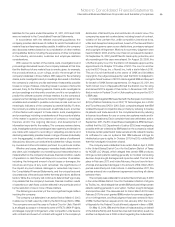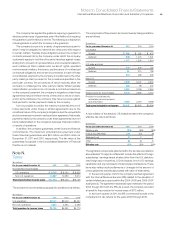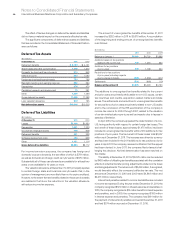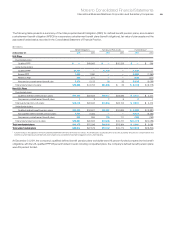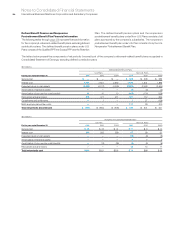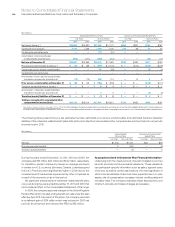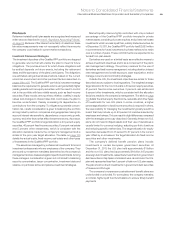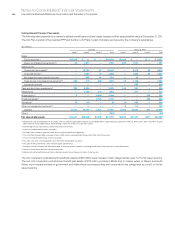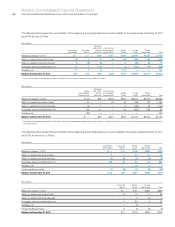IBM 2011 Annual Report Download - page 124
Download and view the complete annual report
Please find page 124 of the 2011 IBM annual report below. You can navigate through the pages in the report by either clicking on the pages listed below, or by using the keyword search tool below to find specific information within the annual report.
Notes to Consolidated Financial Statements
International Business Machines Corporation and Subsidiary Companies122
IBM Excess 401(k) Plus Plan
Effective January 1, 2008, the company replaced the IBM Exec utive
Deferred Compensation Plan, an unfunded, nonqualified, defined
contribution plan, with the IBM Excess 401(k) Plus Plan (Excess
401(k)), an unfunded, nonqualified defined contribution plan. Employees
who are eligible to participate in the 401(k) Plus Plan and whose
eligible compensation is expected to exceed the IRS compensation
limit for qualified plans are eligible to participate in the Excess 401(k).
The purpose of the Excess 401(k) is to provide benefits that would be
provided under the qualified IBM 401(k) Plus Plan if the compensation
limits did not apply.
Amounts deferred into the Excess 401(k) are record-keeping
(notional) accounts and are not held in trust for the participants.
Participants in the Excess 401(k) may invest their notional accounts
in investments which mirror the primary investment options available
under the 401(k) Plus Plan. Participants in the Excess 401(k) are
also eligible to receive company match and automatic contributions
on eligible compensation deferred into the Excess 401(k) and on
compensation earned in excess of the Internal Revenue Code
pay limit once they have completed one year of service. Through
June 30, 2009, eligible participants also received transition credits.
Amounts deferred into the Excess 401(k), including company
contributions are recorded as liabilities in the Consolidated Statement
of Financial Position.
Nonpension Postretirement Benefit Plan
U.S. Nonpension Postretirement Plan
The company sponsors a defined benefit nonpension postretirement
benefit plan that provides medical and dental benefits to eligible U.S.
retirees and eligible dependents, as well as life insurance for eligible
U.S. retirees. Effective July 1, 1999, the company established a Future
Health Account (FHA) for employees who were more than five years
from retirement eligibility. Employees who were within five years of
retirement eligibility are covered under the company’s prior retiree
health benefits arrangements. Under either the FHA or the prior
retiree health benefit arrangements, there is a maximum cost to the
company for retiree health benefits.
Since January 1, 2004, new hires, as of that date or later, are not
eligible for company subsidized nonpension postretirement benefits.
Non-U.S. Plans
Most subsidiaries and branches outside the United States sponsor
defined benefit and/or defined contribution plans that cover
substantially all regular employees. The company deposits funds
under various fiduciary-type arrangements, purchases annuities
under group contracts or provides reserves for these plans. Benefits
under the defined benefit plans are typically based either on years
of service and the employee’s compensation (generally during a
fixed number of years immediately before retirement) or on annual
credits. The range of assumptions that are used for the non-U.S.
defined benefit plans reflect the different economic environments
within the various countries.
In addition, certain of the company’s non-U.S. subsidiaries sponsor
nonpension postretirement benefit plans that provide medical and
dental benefits to eligible non-U.S. retirees and eligible dependents,
as well as life insurance for certain eligible non-U.S. retirees. However,
most non-U.S. retirees are covered by local government-sponsored
and -administered programs.
Plan Financial Information
Summary of Financial Information
The following table presents a summary of the total retirement-related benefits net periodic (income)/cost recorded in the Consolidated
Statement of Earnings.
($ in millions)
U.S. Plans Non-U.S. Plans To t a l
For the year ended December 31: 2011 2010 2009 2011 2010 2009 2011 2010 2009
Defined benefit pension plans $(774) $ (949) $(919) $ 734 $ 541 $ 521 $ (40) $ (408)$ (398)
Retention Plan 15 14 13 —— — 15 14 13
Total defined benefit
pension plans (income)/cost $(759) $(935) $(906) $ 734 $ 541 $ 521 $ (25) $ (394)$ (384)
IBM 401(k) Plus Plan
and Non-U.S. plans $ 875 $ 882 $ 946 $ 608 $ 527 $ 478 $1,483 $1,409 $1,424
Excess 401(k) 30 20 26 —— — 30 20 26
Total defined contribution plans cost $ 905 $ 902 $ 972 $ 608 $ 527 $ 478 $1,513 $1,430 $1,450
Nonpension postretirement
benefit plans cost $ 269 $ 281 $ 292 $ 76 $ 66 $ 58 $ 345 $ 347 $ 350
Total retirement-related
benefits net periodic cost $ 415 $ 248 $ 358 $1,418 $1,134 $1,057 $1,832 $1,382 $1,415



